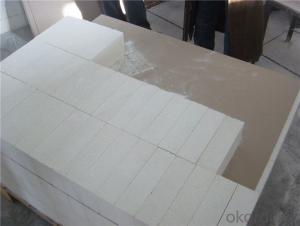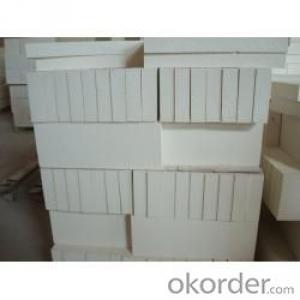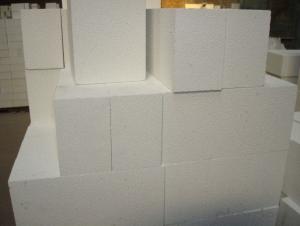Mullite Insulating Brick for Hot Blast Stove
- Loading Port:
- Shanghai
- Payment Terms:
- TT OR LC
- Min Order Qty:
- 1 m.t.
- Supply Capability:
- 1000 m.t./month
OKorder Service Pledge
OKorder Financial Service
You Might Also Like
CNBM conforms strictly to the requirements of ISO 9000 quality control system during the production. MSDS is also available if you want. The thermal insulation fire clay brick meet with the requirements of ASTM & JIS standards. So please stay cool with our quality.
Application
Insulating Fire Brick are used for the lining of converter, alternating current arc furnace, direct Current arc furnace and the ladle slag line, etc.
Insulating Fire Brick Technical index
Brand Quality | JM23 | JM26 | JM28 | JM30 | JM32 | |
Bulk Density (g/cm3) | 0.52 | 0.78 | 0.88 | 1.03 | 1.25 | |
1.2 | 1.6 | 2.1 | 2.5 | 3.5 | ||
Modulus of Rupture (Mpa) | 0.9 | 1.4 | 1.6 | 2.1 | 2.1 | |
-0.5 | 1400℃ -0.4 | 1510℃ -0.5 | 1620℃ -0.9 | 1730℃ -0.9 | ||
Thermal Expansion 1100℃(%) |
0.5 |
0.7 |
0.8 |
0.9 |
1.1 | |
Thermal conductivity(W/m.k)
| 400℃ | 0.14 | 0.27 | 0.32 | 0.41 | 0.49 |
600℃ | 0.16 | 0.29 | 0.34 | 0.43 | 0.50 | |
800℃ | 0.18 | 0.31 | 0.36 | 0.44 | 0.51 | |
1000℃ | 0.20 | 0.33 | 0.38 | 0.45 | 0.53 | |
Al2O3 | 37 | 58 | 67 | 73 | 77 | |
Fe2O3 | 0.7 | 0.7 | 0.6 | 0.5 | 0.4 | |
Equipment
1 unit of Ceramic Abrasive (SG Abrasive) pilot production line
2 units of Compact grain Abrasive pilot production lines
1 unit of high-end coated abrasives (abrasive cloth) production line
2 units of Boron Carbide production lines
3 large flexible crushing and sieving lines for grit production lines
2 units of 2000KVA furnaces for Boron Carbide fusion
6 units of 5000KVA-10000KVA dumping type electric arc furnaces for Brown Fused Alumina fusion
Company Advantage
(1)Long Insulating Fire Brick manufacture history: 25 years manufacturer
(2)Advanced equipment
(3)Diversification of production standards: ISO ANSI FEPA JIS ASTM
(4)Flexible payment: T/T L/C D/P D/A
(5)Professional marketing team and after-sale service
(6)Free sample
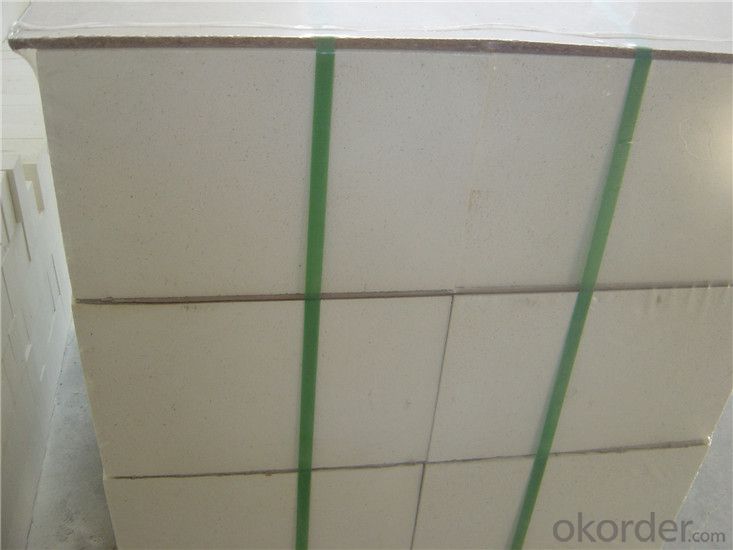
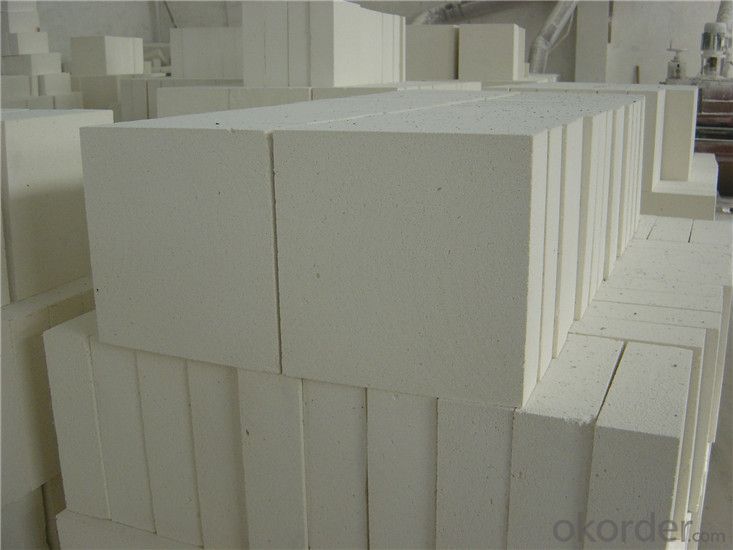
- Q:Can insulating fire bricks be used in cryogenic applications?
- Insulating fire bricks, also known as refractory bricks, are primarily designed for high-temperature applications and are commonly used in furnaces and kilns. However, when it comes to cryogenic applications, where extremely low temperatures are involved, insulating fire bricks may not be the most suitable choice. Cryogenic temperatures, typically below -150 degrees Celsius (-238 degrees Fahrenheit), pose unique challenges for materials due to the severe thermal stresses they experience. Insulating fire bricks are typically composed of materials such as alumina and silica, which have limited thermal shock resistance and can become brittle at very low temperatures. This brittleness can lead to cracking and failure when exposed to cryogenic conditions. Additionally, insulating fire bricks have relatively high thermal conductivity, which means they can conduct heat relatively well. In cryogenic applications, where minimizing heat transfer is crucial, materials with lower thermal conductivity are preferred. Therefore, insulating fire bricks, with their higher thermal conductivity, may not be the most efficient choice for cryogenic applications. Instead, materials with excellent thermal insulation properties and low thermal conductivity, such as aerogels or foams made from materials like silica or carbon, are often preferred for cryogenic applications. These materials offer superior thermal insulation and better resistance to extreme temperatures, ensuring the efficient and reliable performance required in cryogenic environments. In summary, while insulating fire bricks are suitable for high-temperature applications, they may not be the best choice for cryogenic applications due to their brittleness at low temperatures and relatively high thermal conductivity. Materials specifically designed for cryogenic conditions, such as aerogels or foams, are more suitable for these extreme temperature environments.
- Q:Can insulating fire bricks be used in blast furnaces?
- Yes, insulating fire bricks can be used in blast furnaces. Insulating fire bricks are designed to withstand high temperatures and provide excellent thermal insulation, making them suitable for lining the walls of blast furnaces. Their insulation properties help to minimize heat loss and improve energy efficiency in the furnace, ultimately enhancing the overall performance and productivity of the blast furnace.
- Q:Are insulating fire bricks resistant to phosphoric acid?
- Phosphoric acid, being a strong acid, has the potential to react with and corrode various materials, including fire bricks. Although certain fire bricks may possess a degree of resistance to acidic conditions, insulating fire bricks are generally not equipped to endure prolonged exposure to phosphoric acid without experiencing notable deterioration. As a result, it is advisable to employ acid-resistant materials like acid-resistant bricks or linings when handling phosphoric acid or other potent acids.
- Q:Can insulating fire bricks be used in high-temperature insulation for cryogenic applications?
- Insulating fire bricks are not suitable for high-temperature insulation in cryogenic applications. Insulating fire bricks are designed to withstand temperatures up to around 2300°F (1260°C), which is well below the extremely low temperatures required for cryogenic applications. Cryogenic temperatures can range from -150°C to -273°C (-238°F to -459°F), and insulating fire bricks would not be able to provide adequate insulation at these temperatures. Instead, specialized materials such as aerogels or multi-layered insulation systems are commonly used for cryogenic insulation to ensure low heat transfer and maintain the extremely low temperatures required.
- Q:Do insulating fire bricks have a high fire resistance rating?
- Yes, insulating fire bricks have a high fire resistance rating. These bricks are specifically designed to withstand high temperatures and provide excellent insulation, making them ideal for applications where fire resistance is crucial. They can withstand temperatures as high as 3000°F (1650°C), making them highly reliable in various industrial and residential settings that require protection against extreme heat.
- Q:Are insulating fire bricks suitable for use in oil refineries?
- Insulating fire bricks are generally not suitable for use in oil refineries. While insulating fire bricks are designed to withstand high temperatures, they are not resistant to the corrosive and abrasive nature of oil and its byproducts. Oil refineries involve a complex process of refining crude oil into various petroleum products, and this process often exposes the materials used in the refinery to harsh chemicals and high temperatures. Instead, oil refineries typically use refractory bricks or castables that are specifically designed to withstand the corrosive and abrasive conditions found in the refining process. Refractory materials used in oil refineries are resistant to chemical attack, have high strength and thermal shock resistance, and can withstand the extreme temperatures encountered during the refining process. Additionally, oil refineries require materials that can provide excellent insulation properties while also being durable and resistant to thermal stress. Insulating fire bricks, although they have good insulation properties, may not have the necessary durability and resistance to thermal stress required in the demanding environment of an oil refinery. Therefore, it is recommended to use refractory bricks or castables specifically designed for oil refineries, which can provide the necessary resistance to chemicals, high temperatures, and thermal stress, ensuring safe and efficient operation of the refinery.
- Q:Are insulating fire bricks resistant to high-pressure environments?
- Yes, insulating fire bricks are generally resistant to high-pressure environments. These bricks are designed to withstand high temperatures and are often used in applications where pressure is present, such as in kilns, furnaces, and industrial boilers. They have excellent thermal insulation properties and can maintain their structural integrity under significant pressure.
- Q:Can insulating fire bricks be used in rotary kilns?
- Rotary kilns can indeed utilize insulating fire bricks. These bricks are specifically designed to possess low thermal conductivity, enabling them to withstand high temperatures while minimizing heat loss. Consequently, they are well-suited for employment in rotary kilns, which are utilized across various industries for processes like calcination, sintering, and roasting. The application of insulating fire bricks within rotary kilns effectively contains the internally generated heat, resulting in enhanced energy efficiency and cost savings. Moreover, these bricks' insulating properties aid in reducing the temperature on the kiln's outer surface, thereby ensuring a safer working environment for operators. Ultimately, insulating fire bricks serve as an ideal choice for rotary kilns, offering remarkable thermal insulation and contributing to the kiln's overall performance and durability.
- Q:Can insulating fire bricks be used in refractory lining for steelmaking?
- Yes, insulating fire bricks can be used in refractory lining for steelmaking. They are effective in providing insulation and thermal stability, helping to maintain high temperatures and protect the surrounding structures. Additionally, insulating fire bricks have low thermal conductivity and are lightweight, making them suitable for steelmaking processes that require heat retention and energy efficiency.
- Q:Can insulating fire bricks be used as insulation in walls and roofs?
- Insulation in walls and roofs can be achieved by utilizing insulating fire bricks. These bricks are constructed from lightweight materials that possess exceptional thermal insulation properties. Their thermal conductivity is low, allowing them to effectively minimize heat transfer through walls and roofs. Consequently, they are a fitting selection for enhancing energy efficiency and insulating buildings. Furthermore, insulating fire bricks are both long-lasting and fire-resistant, rendering them a secure choice for insulation. Nevertheless, it is crucial to acknowledge that these bricks are typically employed in high-temperature environments such as furnaces and kilns. Thus, they might not be the most economical or practical option for all wall and roof insulation requirements. In terms of cost, installation ease, and overall performance, other insulation materials specifically designed for building applications may be more appropriate.
1. Manufacturer Overview |
|
|---|---|
| Location | |
| Year Established | |
| Annual Output Value | |
| Main Markets | |
| Company Certifications | |
2. Manufacturer Certificates |
|
|---|---|
| a) Certification Name | |
| Range | |
| Reference | |
| Validity Period | |
3. Manufacturer Capability |
|
|---|---|
| a)Trade Capacity | |
| Nearest Port | |
| Export Percentage | |
| No.of Employees in Trade Department | |
| Language Spoken: | |
| b)Factory Information | |
| Factory Size: | |
| No. of Production Lines | |
| Contract Manufacturing | |
| Product Price Range | |
Send your message to us
Mullite Insulating Brick for Hot Blast Stove
- Loading Port:
- Shanghai
- Payment Terms:
- TT OR LC
- Min Order Qty:
- 1 m.t.
- Supply Capability:
- 1000 m.t./month
OKorder Service Pledge
OKorder Financial Service
Similar products
New products
Hot products
Hot Searches
Related keywords
